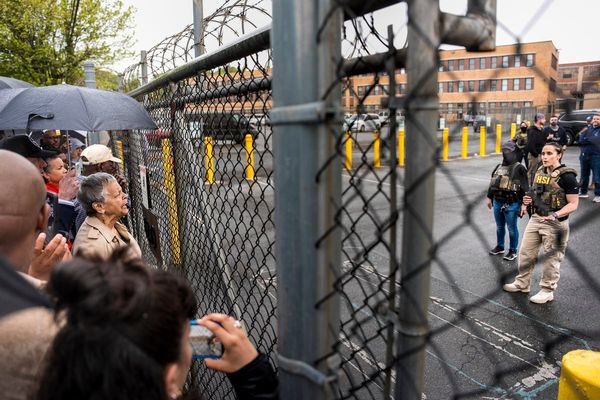
WAKAYAMA -- Used as a fortress by the Japanese military until the end of World War II, the four-island chain of Tomogashima is known as the "Island of Laputa," as it closely resembles the floating island in the Studio Ghibli movie "Castle in the Sky."
Mossy remains of brick gun batteries and other structures can be seen on the heavily wooded Tomogashima, which has been gaining popularity through social media, attracting Ghibli fans from Japan and abroad.
In mid-April, I boarded a ship at Kada Port in Wakayama, and traveled for about 20 minutes to Okinoshima, the largest of the four islets. After walking up a mountain path for about half an hour, I passed through a tunnel and saw a red brick structure, the third gun battery site. It was an important facility constructed to shoot at enemy ships passing through a strait.

It's now been 74 years since the end of the war, and most of the red bricks were faded and covered with moss and ivy.
I groped around in the dark inside of the building that was used as an ammunition depot, and reached the remains of the gun platforms on which cannons were set. I found rainwater collected in the round gun platforms and heard the loud croak of frogs nearby. On the mountain path, I also saw a deer and a squirrel.
The structure -- which seems to have been left behind by time -- looks just like the "Castle in the Sky" floating in the air.

I saw students from Osaka Prefectural Otemae High School who were there on a school outing.
"There're so many things here that I've never seen before. I feel like I've walked into the world of the movie," Kazuaki Shinpo, 17, said excitedly while taking photos.

Social media boosts popularity
The Tomogashima chain of four islands was fortified in the Meiji era (1868-1912). Many war ruins remain here, including those of five gun batteries, a station for detecting the sound of the screws of enemy ships, and a searchlight.
As time went on, battles moved from the sea to the air, and thus these facilities were left unused in actual fights. After the war ended, Tomogashima was designated as a national park, and Nankai Electric Railway Co. developed the islands as a resort area.
Tomogashima attracted about 80,000 to 90,000 visitors annually in the 1960s and the early 1970s, but the figure gradually decreased after that. In 2002, Nankai Electric withdrew from the tourism business.
A regular boat line to the island was suspended, and people gradually forgot Tomogashima.
However, with the rapid growth of social media, information that Tomogashira resembles Laputa began spreading from around 2012.
The number of visitors increased to about 86,000 in fiscal 2017, about five times the level in fiscal 2011. More ferries are operated during the tourist season, but they're not enough to carry all the would-be visitors to the island.
"There are visitors from overseas. I didn't realize this place would attract attention through such means," said Shinsuke Aoki, the head of the Tomogashima Annai Center, who has been working on Tomogashima for more than 30 years.
Memories of war
Last spring, Koji Kasuya, 43, a company employee in Osaka, created a model airplane and Robot Soldier, a character in "Castle in the Sky," and reproduced some of the movie's scenes at various places on Tomogashima.
After posting the photos on social media, he received many comments from Ghibli fans in Japan and abroad, he said.
"I can take photos with an easy mind, since nobody died here in the war," Kasuya said.
More young people have started to visit Tomogashima after seeing it on social media and gaining interest in the history of war, said Mitsujiro Matsuura, 54, who acts as a guide on the islands.
Most of the gun batteries and other war remains have been untouched since the end of the war, and are deteriorating as a result of rain and wind damage.
"They're important remains that convey memories of the war. I hope momentum for preserving them will grow as a result of the many visitors," Matsuura said.
-- Tomogashima, Wakayama Pref.
It is an about 20-minute walk from Nankai Kada Station to Kada Port, from which a regular ferry operated by Tomogashima Kisen takes passengers to Okinoshima in about 20 minutes.
The ferry runs every day except Wednesdays. It runs every day from July 20 through Aug. 31, and on Saturdays, Sundays and holidays from December to February. A round trip ticket is 2,000 yen for adults and 1,000 yen for elementary school students. In addition to the remains of gun batteries, there is a lighthouse, observatory, campsite and lodging facilities on the island.
For more information, call the Tomogashima Annai Center at (073) 459-0314.
Read more from The Japan News at https://japannews.yomiuri.co.jp/







